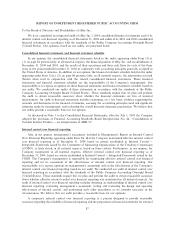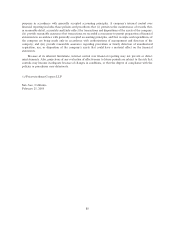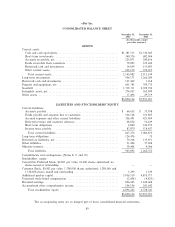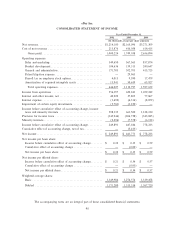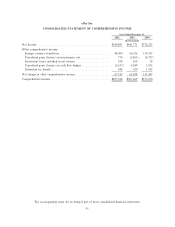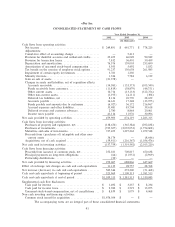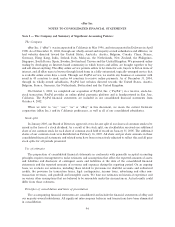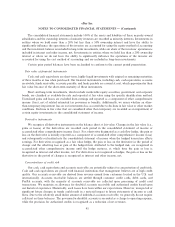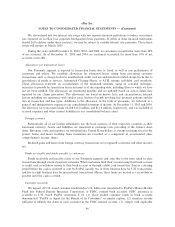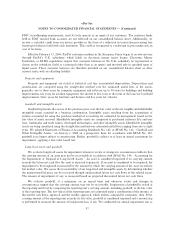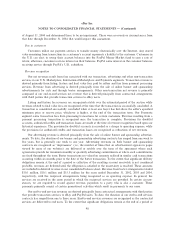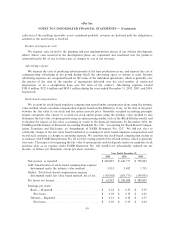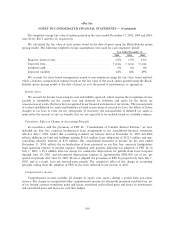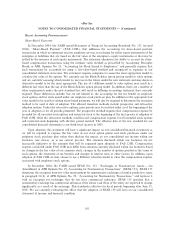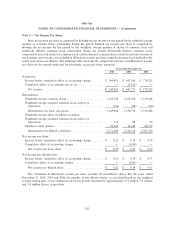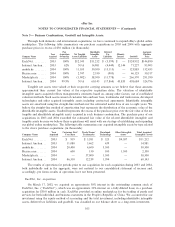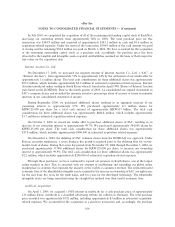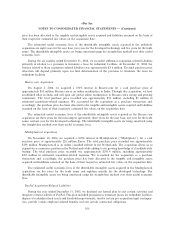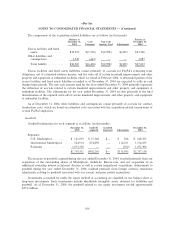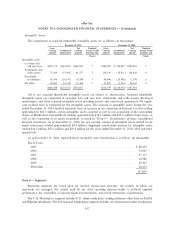eBay 2004 Annual Report Download - page 99
Download and view the complete annual report
Please find page 99 of the 2004 eBay annual report below. You can navigate through the pages in the report by either clicking on the pages listed below, or by using the keyword search tool below to find specific information within the annual report.eBay Inc.
NOTES TO CONSOLIDATED FINANCIAL STATEMENTS Ì (Continued)
FDIC recordkeeping requirements, and (4) truly operate as an agent of our customers. The customer funds
held in FDIC insured bank accounts are not reÖected on our consolidated balance sheet. Additionally, we
receive a custodial credit from our service provider in the form of a reduction in transaction processing fees
based upon balances held with each institution. This credit is recognized as a reduction in processing costs in
cost of revenues.
EÅective February 13, 2004, PayPal customers resident in the European Union began to receive services
through PayPal's U.K. subsidiary, which holds an electronic money issuer license. Electronic Money
Institution, or ELMI, regulations require that customer balances in the U.K. subsidiary be represented as
claims on the subsidiary (held as a principal rather than as an agent) and invested only in speciÑed types of
liquid assets. These customer balances are therefore included on our consolidated balance sheet as other
current assets with an oÅsetting liability.
Property and equipment
Property and equipment are stated at historical cost less accumulated depreciation. Depreciation and
amortization are computed using the straight-line method over the estimated useful lives of the assets,
generally, one to three years for computer equipment and software, up to 30 years for buildings and building
improvements, ten years for aviation equipment, the shorter of Ñve years or the term of the lease for leasehold
improvements, three years for furniture and Ñxtures and Ñve years for vehicles.
Goodwill and intangible assets
Goodwill represents the excess of the purchase price over the fair value of the net tangible and identiÑable
intangible assets acquired in a business combination. Intangible assets resulting from the acquisitions of
entities accounted for using the purchase method of accounting are estimated by management based on the
fair value of assets received. IdentiÑable intangible assets are comprised of purchased customer lists and user
base, trademarks and trade names, developed technologies, and other intangible assets. IdentiÑable intangible
assets are being amortized using the straight-line method over estimated useful lives ranging from one to eight
years. We adopted Statement of Financial Accounting Standards No. 142, or SFAS No. 142, ""Goodwill and
Other Intangible Assets,'' on January 1, 2002 on a prospective basis. In accordance with SFAS No. 142,
goodwill is no longer subject to amortization. Rather, goodwill is subject to at least an annual assessment for
impairment, applying a fair-value based test.
Long-lived assets and goodwill
We evaluate long-lived assets for impairment whenever events or changes in circumstances indicate that
the carrying amount of an asset may not be recoverable in accordance with SFAS No. 144, ""Accounting for
the Impairment or Disposal of Long-Lived Assets.'' An asset is considered impaired if its carrying amount
exceeds the future net cash Öow the asset is expected to generate. If an asset is considered to be impaired, the
impairment to be recognized is measured by the amount by which the carrying amount of the asset exceeds its
fair market value. We assess the recoverability of our long-lived and intangible assets by determining whether
the unamortized balances can be recovered through undiscounted future net cash Öows of the related assets.
The amount of impairment, if any, is measured based on projected discounted future net cash Öows.
We evaluate goodwill, at a minimum, on an annual basis and whenever events and changes in
circumstances suggest that the carrying amount may not be recoverable. Impairment of goodwill is tested at
the reporting unit level by comparing the reporting unit's carrying amount, including goodwill, to the fair value
of the reporting unit. The fair values of the reporting units are estimated using a combination of the income, or
discounted cash Öows, approach and the market approach, which utilizes comparable companies' data. If the
carrying amount of the reporting unit exceeds its fair value, goodwill is considered impaired and a second step
is performed to measure the amount of impairment loss, if any. We conducted our annual impairment test as
97


